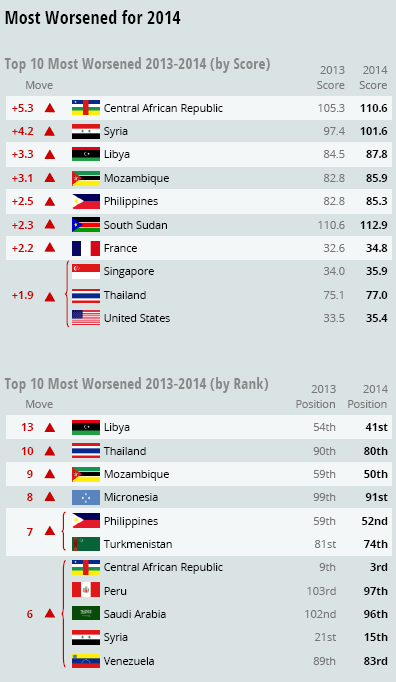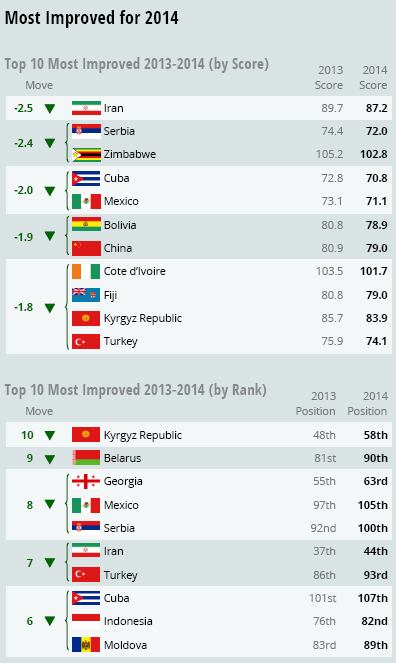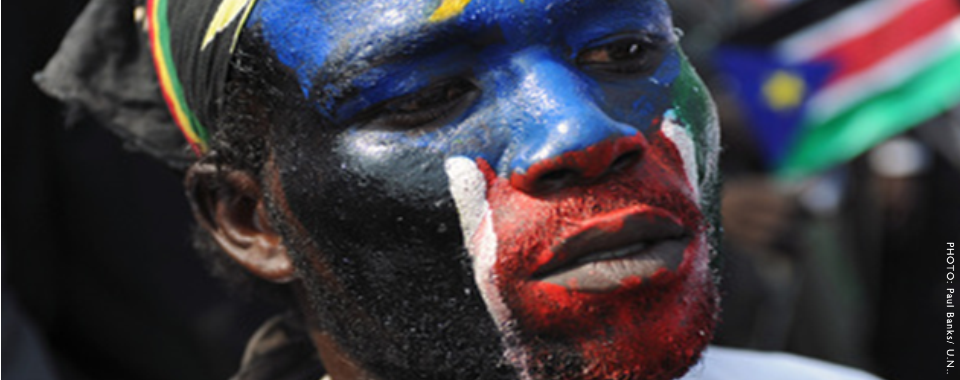BY J.J. MESSNER
As much as the 2014 Fragile States Index is significant for being the tenth anniversary of the Index (and for being the first to be named “Fragile States Index” rather than “Failed States Index”), it is especially notable for the change at the top: after six years in the number one position, Somalia has finally been overtaken, leaving South Sudan as the most fragile state in the world.
South Sudan made its debut in the then-Failed States Index in 2012. After gaining independence in the latter half of 2011, South Sudan was (albeit informally*) ranked fourth in its first appearance in the FSI, a ranking it retained in 2013, though with a worsened score. It now finds itself as only the fourth country to ever top the FSI. The country’s independence, while initially giving cause for celebration, is now giving only cause for concern as its politics and leadership grows increasingly fractious, and mass killings – especially targeting specific ethnic groups – gains momentum.
South Sudan’s spiral into first place has finally ended Somalia’s six-year run atop the Index. But just because Somalia has earned some respite from being FSI’s most fragile state, it does not mean that we should no longer be concerned. Somalia’s score peaked in 2012, as the scourge of piracy off the Horn of Africa reached its apogee. As noted in previous indices, Somalia continues to endure widespread lawlessness, ineffective government, terrorism, insurgency, crime, and abysmal development – but the country does appear to be on a slow trajectory of improvement, so there is cause for some hope.
 Though South Sudan took first place on the Index this year, it was only the sixth most-worsened country. The most-worsened country for 2014 is Central African Republic, which was beset by civil war, widespread atrocities, and the deployment of a French-led peacekeeping force. Following closely behind the Central African Republic was Syria, where the continued (and worsening) civil war plunged that country even deeper into the fragile end of the Index. After ranking 48th as recently as 2011, Syria now finds itself at 15th. Syria was also the third most-worsened country in both the 2012 and 2013 FSIs, demonstrating the freefall that the country is experiencing. [See also our coverage on the Syria] In a similar situation is Libya, 2014’s third-most worsened country. In the 2012 Index, Libya set a record for the most severe year-on-year worsening of a country in the history of the Index (a record that still stands), rising from 50th to 11th as the civil war’s effects took hold. Libya stabilized somewhat in 2013 as it began to rebuild in the aftermath of the Qaddafi era. Recently however, renewals of violence have seen Libya’s situation worsens yet again.
Though South Sudan took first place on the Index this year, it was only the sixth most-worsened country. The most-worsened country for 2014 is Central African Republic, which was beset by civil war, widespread atrocities, and the deployment of a French-led peacekeeping force. Following closely behind the Central African Republic was Syria, where the continued (and worsening) civil war plunged that country even deeper into the fragile end of the Index. After ranking 48th as recently as 2011, Syria now finds itself at 15th. Syria was also the third most-worsened country in both the 2012 and 2013 FSIs, demonstrating the freefall that the country is experiencing. [See also our coverage on the Syria] In a similar situation is Libya, 2014’s third-most worsened country. In the 2012 Index, Libya set a record for the most severe year-on-year worsening of a country in the history of the Index (a record that still stands), rising from 50th to 11th as the civil war’s effects took hold. Libya stabilized somewhat in 2013 as it began to rebuild in the aftermath of the Qaddafi era. Recently however, renewals of violence have seen Libya’s situation worsens yet again.
Though there are plenty of countries about which to be concerned, there is also cause for optimism among many other countries. Despite plenty of coverage and continued concerns, particularly about its nuclear program, and despite being the target of wide-ranging sanctions, Iran nevertheless managed to be the most-improved nation in 2014, with the country stabilizing somewhat after recent political and social turmoil. Quite coincidentally, the list of most-improved countries for 2014 was largely a collection of countries that have endured frosty relations with the United States in recent memory, including Iran, Serbia, Zimbabwe, Cuba, Bolivia, and China.
It could be easy to view the FSI as being relevant only to analysis of countries already considered to be weak and/or fragile. But this year’s Index demonstrates that even developed countries are not immune to significant pressures. France was the 7th-most worsened country in 2014, largely as a result of a political and economic malaise, with a similar situation befalling the United States, which was tied at equal 8th most-worsened along with Singapore. Also within the top 20 most-worsened countries for 2014 were Switzerland, the Netherlands, Sweden, and Austria.
Now that we have ten years of FSI data, we are able to demonstrate long-term trends. In the period since 2006, the greatest gains have been made by Bosnia-Herzegovina and Indonesia. Interestingly, four of the top ten most-improved countries over this period are constituent parts of the former Yugoslavia – along with Bosnia-Herzegovina, Serbia ranks as the third-most improved and Croatia as tenth. Further, to the earlier point about the worsening experience by a number of developed countries, Germany is the only large, developed country to figure in the top-ten most-improved, with the only other developed nations joining it in the top 50 being Poland, the Baltic states, and South Korea.
Meanwhile, the long-term trends demonstrating the most-worsened countries over the past decade should come as no surprise. Libya is by far the most-worsened country, along with Senegal, Mali, Guinea Bissau, the Central African Republic, and Syria. Though Tunisia is widely regarded as having weathered the Arab Spring better than most of its regional neighbors, it has nevertheless experienced a significant amount of turbulence, leaving it the eighth-most worsened country in the past decade.
 Perhaps one of the least obvious developments of the past decade has been the improving fortunes of Sierra Leone. In 2005, Sierra Leone ranked in the FSI’s first ever Top 10. But in the intervening decade, this formerly civil war-wracked country has managed to gradually rise again. This year, Sierra Leone has become the first ever country to exit the “Alert” category after having once been as high as the Top 10. Of course, this does not mean that Sierra Leone is out of the woods. But it does demonstrate how even countries that were once war-ravaged can slowly recover to increasing levels of stability. Liberia, too, also featured in that initial Top 10 in 2005, and its progress in the past decade has shown that it may well follow Sierra Leone out of the Alert category in the coming years.
Perhaps one of the least obvious developments of the past decade has been the improving fortunes of Sierra Leone. In 2005, Sierra Leone ranked in the FSI’s first ever Top 10. But in the intervening decade, this formerly civil war-wracked country has managed to gradually rise again. This year, Sierra Leone has become the first ever country to exit the “Alert” category after having once been as high as the Top 10. Of course, this does not mean that Sierra Leone is out of the woods. But it does demonstrate how even countries that were once war-ravaged can slowly recover to increasing levels of stability. Liberia, too, also featured in that initial Top 10 in 2005, and its progress in the past decade has shown that it may well follow Sierra Leone out of the Alert category in the coming years.
As important as it is to recognize what the 2014 FSI is telling us, it is also important to recognize what it is not telling us – well, at least not yet. Undoubtedly, many observers will likely look to Ukraine and wonder why, after the break-out of violence and the annexation of Crimea by Russia, Ukraine ranks relatively comfortably at 113th place, having worsened by only 1.3 points since 2013. Or, why Iraq improved in 2014 while Islamists now seem to be on the verge of sparking a renewed civil war. Or, why Thailand is ranked 80th while now having been the subject of (yet another) military coup.
Of course, the FSI is very much a lagging ‘indicator’ in the way that rates of unemployment or inflation are lagging indicators for an economy. The content analysis of over 40 million sources, along with the triangulation of quantitative and qualitative data, followed by verification, validation, and substantive analysis is a process that takes months. This means that by the time the data is finally assembled, events have continued to unfold – much of the tumult in Iraq, Thailand, and Ukraine occurred subsequent to the end of the 2014 FSI’s sample period that ended on December 31st. Indeed, this situation is reminiscent of Libya in the 2012 FSI. As civil war raged in Libya, the country continued to rank as relatively stable in the FSI. While the conflict had progressed rapidly, critically for the FSI, the conflict had largely progressed after the December 31 cut-off for that year’s Index.
Nevertheless, two of the most destabilized countries in the first half of 2014 were registering worsening trends over the past 12 months – along with Ukraine’s worsening, Thailand, another country to experience severe instability this year with its recent military coup, also saw its score slip by 1.9 points in the 2014 FSI, ranking as the tenth most-worsened country for 2014. And among all three countries, Iraq, Thailand, and Ukraine all experienced significantly worsening pressures in the past few years on the key indicators of Group Grievance, State Legitimacy, and Human Rights and Rule of Law. Though this year’s instability of neither Iraq, Thailand, or Ukraine has yet registered in the 2014 FSI, it is clear that they were on the slide even before the current levels of stress took hold. Unless the situation in these countries improves markedly in the next six months, it is reasonable to expect that the scores of all three countries will slip significantly in the 2015 FSI.
The FSI continues to demonstrate some key lessons about development and stability. Countries like South Sudan, the Central African Republic, and Syria demonstrate how all-consuming and damaging conflict is. Countries such as Libya and Tunisia further demonstrate that just when we think that conflict is over, it can for a long-time remain an ever-present specter that can continually threaten to re-emerge. The recent worsening of the United States, France, and Singapore also shows us that instability is not exclusive to developing countries.
But the FSI also demonstrates that for all the negativity, there is actually more reason for optimism. Sierra Leone and Bosnia-Herzegovina show us that recovery from conflict is possible, albeit over a long period of time — true fundamental change and development takes a generation or more. We should also not ignore the fact that, for the fifth year in succession, more countries have either improved or remained steady from the previous year than have worsened, implying that overall the world is becoming a more stable place.
